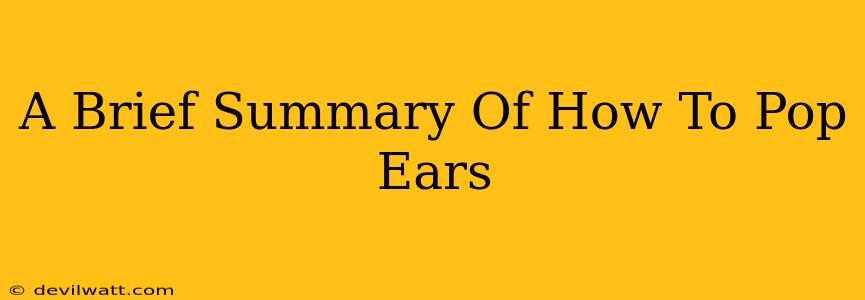Experiencing that uncomfortable pressure in your ears, that feeling of being "plugged up"? It's a common sensation, often caused by changes in altitude (like on a plane or driving up a mountain) or even just a stuffy nose. Fortunately, there are several simple techniques to help you pop your ears and relieve that pressure. This guide provides a brief summary of how to do it safely and effectively.
Understanding Why Your Ears Pop
Before we dive into the solutions, let's quickly understand the cause. Your ears have a small, air-filled space called the middle ear. Normally, the pressure inside this space matches the pressure outside. When there's a pressure difference (like when you ascend in an airplane), this imbalance can cause discomfort. The popping sound you hear is the result of your Eustachian tubes, tiny canals connecting the middle ear to the back of your throat, opening and equalizing the pressure.
Simple Techniques to Pop Your Ears
Here are a few methods you can try to encourage your Eustachian tubes to open and relieve the pressure:
The Valsalva Maneuver:
This is the most common and often effective method.
- Pinch your nostrils closed.
- Close your mouth.
- Gently blow air out of your nose as if you were trying to clear your nostrils. Don't blow too hard! A gentle, sustained effort is key. You should feel a popping sensation as the pressure equalizes.
Important Note: Avoid forcefully blowing as this can damage your eardrums. If this maneuver doesn't work, don't force it.
The Toynbee Maneuver:
This method involves swallowing or yawning.
- Close your mouth and pinch your nostrils closed.
- Try swallowing or yawning. The act of swallowing helps to open the Eustachian tubes.
The Frenzel Maneuver:
This is a more advanced technique, often used by divers and pilots. It involves closing your mouth and nostrils, then making a "k" sound in your throat, without using your lungs. It is similar to the Valsalva Maneuver but requires more practice.
Other Helpful Tips:
- Yawning: A natural yawn can often help open your Eustachian tubes.
- Chewing Gum or Sucking on Candy: The swallowing action involved can assist in pressure equalization.
- Head Tilts: Gently tilting your head can sometimes help. Try tilting your head to one side, then the other.
- Hydration: Staying well-hydrated can help keep your Eustachian tubes lubricated.
When to Seek Medical Attention
While these methods usually work effectively, it's important to seek medical advice if you experience:
- Persistent ear pain
- Significant hearing loss
- Discharge from your ear
- Frequent or severe ear pressure issues
These could indicate an underlying medical problem requiring professional attention.
Conclusion
Popping your ears is often a simple process, but understanding the proper techniques is crucial. Start with gentle methods like the Valsalva maneuver and remember to listen to your body. If you experience persistent issues or discomfort, always consult with a doctor or healthcare professional.

